1. What Is a cast iron kadai?
Traditional Design
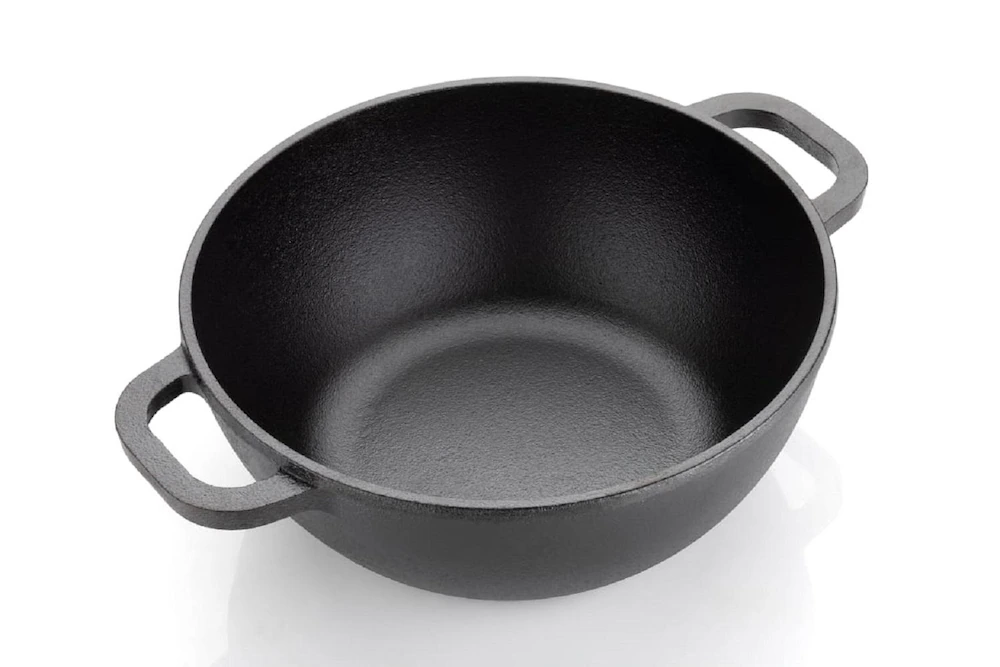
cast iron kadai is a deep, round-bottomed cooking pan made entirely of cast iron, traditionally used in Indian kitchens for frying, sautéing, and slow-cooking. It usually features two short handles for grip and thick walls for even heat distribution. buy cast iron cookware online India.
Modern Versions and Uses
While rooted in tradition, modern cast iron kadhais come pre-seasoned and compatible with gas, electric, and induction stovetops. They’re ideal for making everything from pakoras to pasta sauces.
2. The Culinary Heritage of cast iron kadai Cookware
Origins in Indian Cooking
Cast iron cookware, especially the kadai, has been a staple in Indian kitchens for centuries. Grandmothers swore by it for everything from bhindi masala to mutton curry.
Cultural Importance in Meals
Beyond utility, the kadai carries emotional weight. It’s often passed down through generations as a family heirloom—a symbol of warmth, flavor, and care.
3. Why Cast Iron Is Making a Comeback
Trends in Traditional Cooking
With a growing shift toward slow, mindful cooking, many chefs and home cooks are returning to cast iron for its authenticity and simplicity.
Sustainable & Long-Lasting Tools
Unlike nonstick pans that wear out in a year or two, a well-maintained cast iron kadai can last a lifetime—and even improve with age.
4. Health Benefits of Cooking with cast iron kadai
Natural Iron Supplementation
Cooking acidic foods in cast iron can slightly increase the iron content of the dish, which is especially beneficial for those with iron deficiency.
No Toxic Coatings
Unlike Teflon-coated cookware, cast iron doesn’t release toxic fumes or microplastics. It’s a safer choice for you and your family.
5. Durability and Lifespan
Generational Cookware
Cast iron kadhais are virtually indestructible. They resist warping, scratching, and denting even with heavy use.
Scratch & Warp Resistance
Whether you’re deep frying or dry roasting, this kadai won’t fail you—it handles high heat with ease and integrity.
6. Versatility in the Kitchen
Deep Frying
Crispy samosas, pakoras, and puris turn out perfectly golden in a cast iron kadai due to its superior heat retention.
Searing, Roasting, and Sauteing
You can sear meats, roast vegetables, or stir-fry noodles all in one pan. It moves seamlessly from stovetop to oven.
Oven-to-Table Cooking
Its rustic appeal also makes it suitable for serving, especially at festive gatherings or family-style meals.
7. Flavor Enhancement with cast iron kadai
Natural Seasoning
Over time, your kadai develops a seasoning layer—adding depth and richness to every dish you cook.
Better Heat Retention
It holds heat longer, so food stays warm even after cooking, making it ideal for dinner parties.
Uniform Cooking
No hot spots here—just evenly cooked food, every time.
8. Cast Iron vs. Nonstick vs. Stainless Steel
| Feature | Cast Iron Kadai | Nonstick Cookware | Stainless Steel |
|---|---|---|---|
| Durability | Lasts for decades | Short-term use | Long-lasting |
| Health Impact | Adds iron naturally | May leach toxins | Neutral |
| Heat Retention | Excellent | Poor | Moderate |
| Price | Moderate | Inexpensive | Expensive |
| Maintenance | Needs seasoning | Easy | Requires scrubbing |
9. Caring for Your cast iron kadai
Cleaning Tips
Wipe clean with a soft sponge. Avoid dish soap and always dry immediately to prevent rust.
Seasoning Process
Apply a thin layer of oil and heat it until it smokes lightly. This creates a non-stick coating over time.
Storage and Maintenance cast iron kadai
Store in a dry place. Occasionally re-season to maintain the protective layer and prevent rusting.
10. Best Foods to Cook in a cast iron kadai
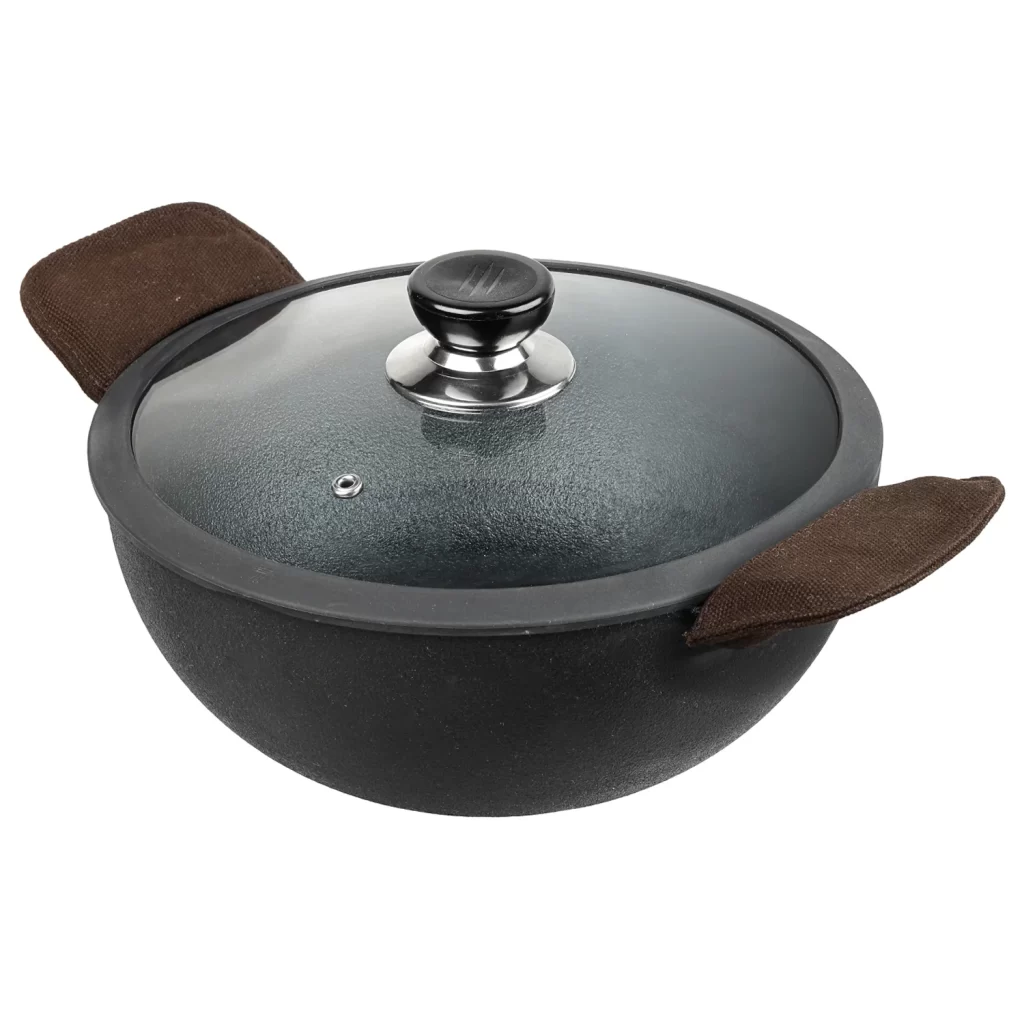
- Curries: Like paneer butter masala or chicken curry
- Fried Snacks: Pakoras, samosas, or papads
- Vegetable Sabzis: Aloo gobi, bhindi fry
- Rice Dishes: Pulao, khichdi
- Sweets: Halwa and laddoos
11. Common Mistakes to Avoid
- Don’t use soap unless absolutely necessary
- Avoid acidic foods (like tomatoes) in a newly seasoned kadai
- Never leave it wet—dry immediately
- Don’t store food in it overnight
12. Cast Iron for Modern Kitchens
Gas, Induction, and Oven Compatibility
Modern cast iron kadhais are designed to work on all heat sources—including induction stoves and ovens.
Blending Traditional with Modern Styles
Newer models come with stylish matte finishes, ergonomic handles, and even lids—blending tradition with functionality.
13. Where to Buy a High-Quality Cast Iron Kadai
Trusted Indian Brands
- Lodge
- Rock Tawa
- Meyer Pre-Seasoned
- Vinod Legacy
Online vs. Offline Options
You can find great deals on Amazon, Flipkart, and brand websites. Local kitchenware stores may also carry regional handmade options.
Price Guide
Expect to spend ₹900–₹2,500 ($15–$30 USD) depending on size, weight, and brand.
14. Real User Testimonials cast iron kadai
“Cooking in a cast iron kadai changed my entire approach to food—it’s healthier, tastier, and feels authentic.” – Neha S.
“I inherited my grandmother’s kadai. After 40 years, it still works like magic!” – Ravi K.
“I love that it works on my induction stove. Feels traditional but functions modern.” – Alisha D.
15. Frequently Asked Questions (FAQs)
1. Is cast iron safe for daily cooking?
Yes. It’s one of the safest materials, especially when seasoned well.
2. Does cast iron really increase iron content in food?
Yes, particularly when cooking acidic or wet dishes.
3. Can I use it on induction stoves?
Yes, if it has a flat base designed for induction compatibility.
4. How do I remove rust from it?
Scrub with steel wool, rinse, dry, and re-season.
5. Is it okay to cook tomato-based dishes in cast iron?
Yes, but only after the kadai is well-seasoned.
6. How often should I season my kadai?
Once every few weeks, or whenever it looks dry or sticky.
16. Final Thoughts and Recommendation
A cast iron kadai isn’t just cookware—it’s an investment in health, flavor, and tradition. Whether you’re frying pakoras for a rainy evening or slow-cooking biryani for a celebration, this timeless tool enhances the experience. Add one to your kitchen today—and pass it on tomorrow.


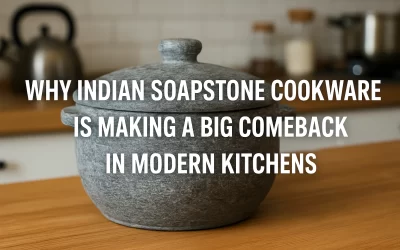
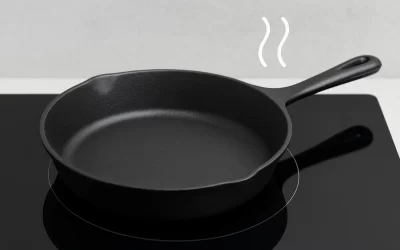
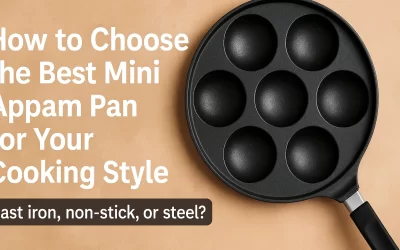
0 Comments